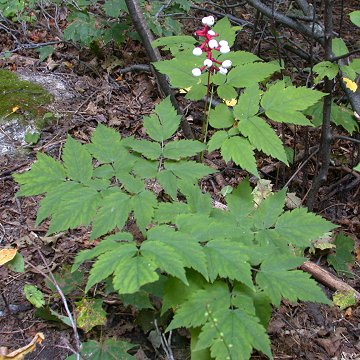

Actaea pachypoda - (image 1 of 5)
Taxonomy
Family: Ranunculaceae
Habitat
Mesic woods
Associates
Frequently occurs with Acer saccharum
Distribution
Most of the eastern half of the US
Morphology
Perennial herb. Leaves alternate, compound, 2 or 3-pinnate, typically glabrous beneath. Flowers are white on stout pedicels. Fruits usually white with a dark spot in the middle, with the pedicels often turning pinkish as maturity.
Notes
Flowers late April to early June
Wetland Indicator: Upland
The white fruits with black centers give this plant the common name of "doll's eyes". Note the thick flowering stalks (pedicels) that are also evident when the plant is in fruit. It is called baneberry because the berries are toxic to humans, as is the foliage. See A. rubra for an idea of what the flowers would look like and note the difference in the thickness of pedicels (stalk supporting the flowers/fruit).
While the fruit is usually white it can occasionally be red. The last two images show a plant with red fruit and pedicels.
References
Foster, S. and R.A. Caras. 1994. A Field Guide to Venomous Animals and Poisonous Plants: North America North of Mexico.
Houghton Mifflin Company. New York, NY. 244 pp.
Swink, F. and G.
Wilhelm. 1994. Plants of the Chicago Region.
Indiana Academy of Science. The Morton Arboretum. Lisle, Illinois.
USDA, NRCS. 2002.
The PLANTS Database, Version 3.5 (http://plants.usda.gov).
National Plant Data Center, Baton Rouge, LA 70874-4490 USA
|
© Michael Hough 2004 |